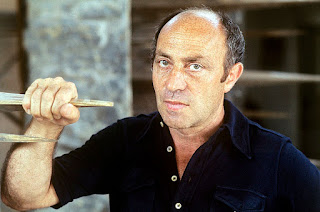NEW - Arnaldo Pomodoro - sculptor
Romagnolo artist best known for his Sphere within Sphere series
The avant-garde sculptor Arnaldo Pomodoro, who became famous for a series of monumental spherical bronze sculptures with their outer surface cracked to reveal intricate interiors, was born in Morciano di Romagna, a small town just inland from the Adriatic coast, on this day in 1926. Pomodoro’s first Sphere within Sphere (Sfera con Sfera) was installed in the Cortile della Pigna courtyard at the Vatican Museums in Roma in the 1960s and he has subsequently produced versions for many locations around the world. These include Trinity College, Dublin, the United Nations Plaza and Mount Sinai Hospital in New York, museums in Washington D.C., Tehran and Tokyo and on the beach front at Pesaro, another Adriatic resort not far from Pomodoro’s birthplace. Broadly speaking, the sculptures, which contain a smaller sphere at the centre of the larger, broken sphere, separated by layers of what look a little like the inner workings of a watch, represent the fragility of the world or of society and the complexities that lie beneath the surface. He was interested in art from a young age, when he was inspired by the countryside and architecture of Montefeltro, an historical region close to where he grew up. Read more…
_______________________________________
Giuseppina Tuissi - partisan
Key figure in capture and execution of Mussolini
Giuseppina Tuissi, who was among a group of partisans who captured the deposed Fascist leader Benito Mussolini as he tried to escape to Switzerland in 1945, was born on this day in 1923 in Abbiategrasso, near Milan. Tuissi and her comrades seized Mussolini at Dongo, a small town on the shores of Lake Como, on April 27, 1945, along with his mistress Claretta Petacci. Having heard that Hitler was preparing to surrender to the Allies, Mussolini was trying to reach Switzerland before flying on to Spain in the hope of finding refuge under Franco’s nationalist dictatorship. He and Petacci and their entourage were executed at the village of Giulino di Mezzegra the following day before the partisan group took their bodies to be put on public display in Milan. Tuissi, however, would herself be killed less than a couple of months later, probably at the hands of fellow partisans who suspected her of betraying comrades during a period earlier in the year in which she had been held captive and tortured by Fascist militia and handed over to the Nazis but was then released. Although she was born in Abbiategrasso, about 30km (19 miles) southwest of Milan, Tuissi lived and worked in Baggio, a suburb of Milan. Read more…
____________________________________
Francesca Schiavone – tennis player
First Italian woman to win a Grand Slam
Tennis champion Francesca Schiavone was born on this day in 1980 in Milan. When she won the French Open at Roland Garros in 2010 she became the first Italian woman to win a Grand Slam event in singles. She was the runner-up in the French Open final the following year. To date she is also the last one-handed backhand player to win a Grand Slam title on the women’s tour. Schiavone has won six titles on the WTA tour and has also been the runner up in events 11 times. Her highest career ranking is World Number Four, which she achieved in January 2011. She has helped Italy win the Federation Cup in 2006, 2009 and 2010 and she has had the most wins for the Italian team. She also appeared in the women’s doubles final at the 2008 French Open. At the 2016 French Open in May it was mistakenly announced that Schiavone was retiring from tennis after she was defeated in the first round of the competition. She retired from tennis after the 2018 US Open. In December 2019, Schiavone revealed she had been diagnosed with cancer earlier in the year but after successful treatment she was free of the disease. Read more…
____________________________________
Claudio Capone – actor and dubber
The Italian voice of a host of stars
Italy lost one of its most famous voices on this day in 2008 with the premature death of Claudio Capone. The Rome-born actor was working in Scotland when he suffered a stroke. He was admitted to hospital in Perth but despite the best efforts of doctors he died two days later, at the age of only 55. Although he began his career with the ambitions of any actor to reach the top of his profession, he was offered an opportunity only a few years out of drama school to do some voice-over work and found the flow of work in dubbing to be so consistent he ultimately made it his career. Unlike some countries, Italian cinema and TV audiences have always preferred to watch imported films and TV shows with dubbed Italian voices rather than subtitles, which meant that a talented dubbing actor was seldom unemployed. Capone was among the best and it was down to him that many foreign stars became famous in Italy, even though many did not speak a word of Italian. The biggest example of this was the American actor Ronn Moss, who played the part of fashion magnate Ridge Forrester in the CBS soap opera The Bold and the Beautiful. Read more…


.jpg)


.jpg)



.jpg)





.jpg)




.jpg)



.jpg)

.jpg)
